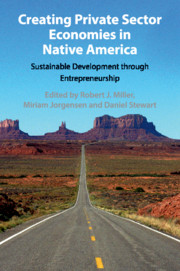 Creating Private Sector Economies in Native America
Creating Private Sector Economies in Native America from Part IV - From Learning to Doing: Examples of Entrepreneurship in Indian Country
Published online by Cambridge University Press: 15 October 2019
There is a budding food sovereignty movement taking place in Native American communities. An important part of this movement includes the development of food and agricultural businesses by Native nations and by individual farmers and ranchers. This chapter examines the history of Native American food systems and one particular element of the Native American food sovereignty movement, the Native American youth-led movement to develop social enterprises around Native American food and food systems. The chapter demonstrates that the food sovereignty movement in Native communities is an important contributor to Native American youth and enterprise development – and vice versa.
To save this book to your Kindle, first ensure [email protected] is added to your Approved Personal Document E-mail List under your Personal Document Settings on the Manage Your Content and Devices page of your Amazon account. Then enter the ‘name’ part of your Kindle email address below. Find out more about saving to your Kindle.
Note you can select to save to either the @free.kindle.com or @kindle.com variations. ‘@free.kindle.com’ emails are free but can only be saved to your device when it is connected to wi-fi. ‘@kindle.com’ emails can be delivered even when you are not connected to wi-fi, but note that service fees apply.
Find out more about the Kindle Personal Document Service.
To save content items to your account, please confirm that you agree to abide by our usage policies. If this is the first time you use this feature, you will be asked to authorise Cambridge Core to connect with your account. Find out more about saving content to Dropbox.
To save content items to your account, please confirm that you agree to abide by our usage policies. If this is the first time you use this feature, you will be asked to authorise Cambridge Core to connect with your account. Find out more about saving content to Google Drive.